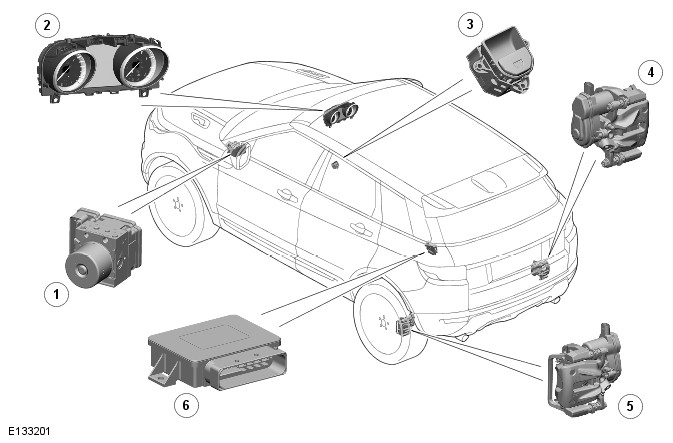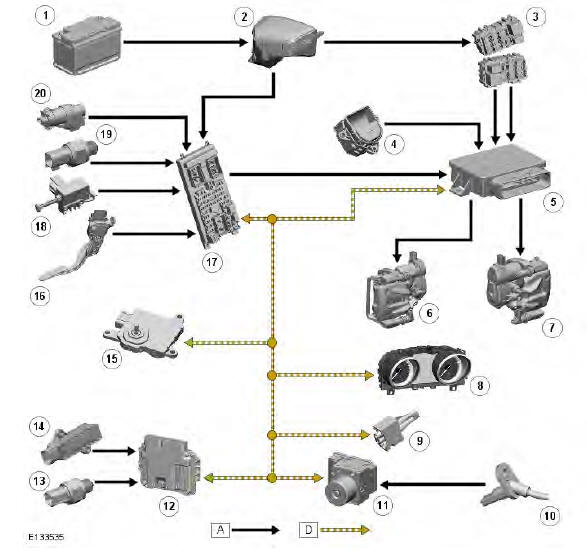Range Rover Evoque: Parking Brake and Actuation
Parking Brake - Component Location
NOTE: RHD (right-hand drive) installation shown, LHD (left-hand drive) installation similar.
COMPONENT LOCATION

- ABS (anti-lock brake system) module
- Instrument cluster
- EPB (electronic parking brake) switch
- RH (right-hand)EPB actuator
- LH (left-hand)EPB actuator
- EPB module
Parking Brake - Overview
OVERVIEW
The EPB (electronic parking brake) is an electrically actuated system that operates the calipers on the rear brakes. The system consists of:
- An EPB switch.
- Two EPB actuators.
- A clutch position sensor (manual transmission vehicles only).
- An EPB module.
- Two warning indicators.
The EPB is controlled by the EPB module, which uses the EPB actuators to apply and release the rear disc brakes.
Operation of the EPB is initiated by the EPB switch and software within the EPB module. The EPB has the following operating modes:
- Static apply/release.
- Gradient dependant apply.
- Ignition off apply.
- DAR (drive away release).
- Automatic transmission apply/release.
- High temperature re-clamp.
- Driver exit warning.
- Dynamic apply.
Signals from other vehicle systems for operation of the EPB are transmitted to the EPB module on the high speed CAN (controller area network) bus.
Parking Brake - System Operation and Component Description
Control Diagram
NOTE: A = Hardwired; D = High speed CAN (controller area network) bus.

- Battery
- EJB (engine junction box)
- RJB (rear junction box)
- EPB (electron c parking brake) switch
- EPB module
- LH (left-hand)EPB actuator
- RH (right-hand)EPB actuator
- Instrument cluster
- Diagnostic socket
- Wheel speed sensor (4 off)
- ABS (anti-lock brake system) module
- ECM (engine control module)
- 1st gear switch (manual transmission vehicles only)
- Neutral sensor (manual transmission vehicles only)
- TCM (transmission control module) (automat c transmission vehicles only)
- APP (accelerator pedal position) sensor
- CJB (central junction box)
- Clutch position sensor (manual transmission vehicles only)
- Reverse gear switch (manual transmission vehicles only)
- Stop lamp switch
System Operation
When the parking brake is applied with the EPB switch, the EPB module uses the wheel speed inputs from the ABS module to determine when to use the static and dynamic modes of operation. It uses the static mode at vehicle speeds up to 2 mph (3 km/h) and the dynamic mode at vehicle speeds greater than 2 mph (3 km/h).
STATIC APPLY/RELEASE
For the static apply to operate, the ignition can be on or off. When the EPB switch is pulled up, the EPB module activates both EPB actuators to apply the brakes and signals the instrument cluster to turn on the red parking brake warning indicator. The warning indicator remains on continuously while the ignition is on, and for 10 seconds after the ignition goes off.
For the static release to operate, the ignition must be on and the brake pedal pressed. When the EPB switch is pressed down, the EPB module then activates both EPB actuators to release the brakes and signals the instrument cluster to turn off the red parking brake warning indicator.
GRADIENT DEPENDANT APPLY
For all static apply modes, the EPB module varies the clamp load applied by the EPB actuators depending on the gradient the vehicle is on. On gradients of less than 10% a reduced clamp load of 13.5 kN is applied. On gradients of 10% and above the nominal clamp load of 16.5 kN is applied.
Gradient dependant apply is inhibited, and the nominal clamp load of 16.5 kN applied on gradients of less than 10%, if the EPB switch is held in the apply position for more than 3 seconds.
IGNITION OFF APPLY
The EPB is automat cally applied when the ignition is switched off.
The EPB module inhibits the ignition off apply operation if the EPB switch is held down, the ignition is turned off within 5 seconds, and the EPB switch is then held down for a further 2 seconds.
DRIVE AWAY RELEASE
With the vehicle static and the parking brake applied, the DAR (drive away release) mode gradually reduces the clamp load when the accelerator pedal is pressed, without the EPB switch being set to the release position, to assist with a smooth drive away. This mode is only active if either the driver door is closed, or if the driver safety belt is buckled and the engine is running.
The point at which the EPB module releases the brakes is determined by the following factors:
- Tilt angle - from the inclination sensor in the EPB module.
- Engine torque - from the ECM.
- Throttle pedal applied - from the APP sensor.
- Clutch pedal releasing - from the clutch position sensor (manual transmission vehicles).
- 1st or reverse gear selected - from the 1st and reverse gear switch (manual transmission vehicles).
- D (drive) or R (reverse) selected - from the TCM (automatic transmission vehicles).
DAR operation can be delayed by holding the EPB switch in the applied position, then releasing it at the required time.
AUTOMATIC TRANSMISSION APPLY/RELEASE
The parking brake is automatically applied on vehicles with automatic transmission when P (park) is selected.
The parking brake is automatically released when the transmission selector is taken out of P, provided either the driver door is closed, or the driver safety belt is buckled, the brake pedal is applied and the engine is running.
HIGH TEMPERATURE RE-CLAMP
After heavy use of the brakes the disc temperatures can be extremely high. At high brake disc temperatures, if the vehicle is stationary and the parking brake is applied, the EPB module automat cally re-applies the parking brake as the brake discs cool down. A temperature model in the EPB module software calculates the brake disc temperature from brake application force, the time the brake force is applied and vehicle speed.
High temperature re-clamp occurs at brake disc temperatures of 300

